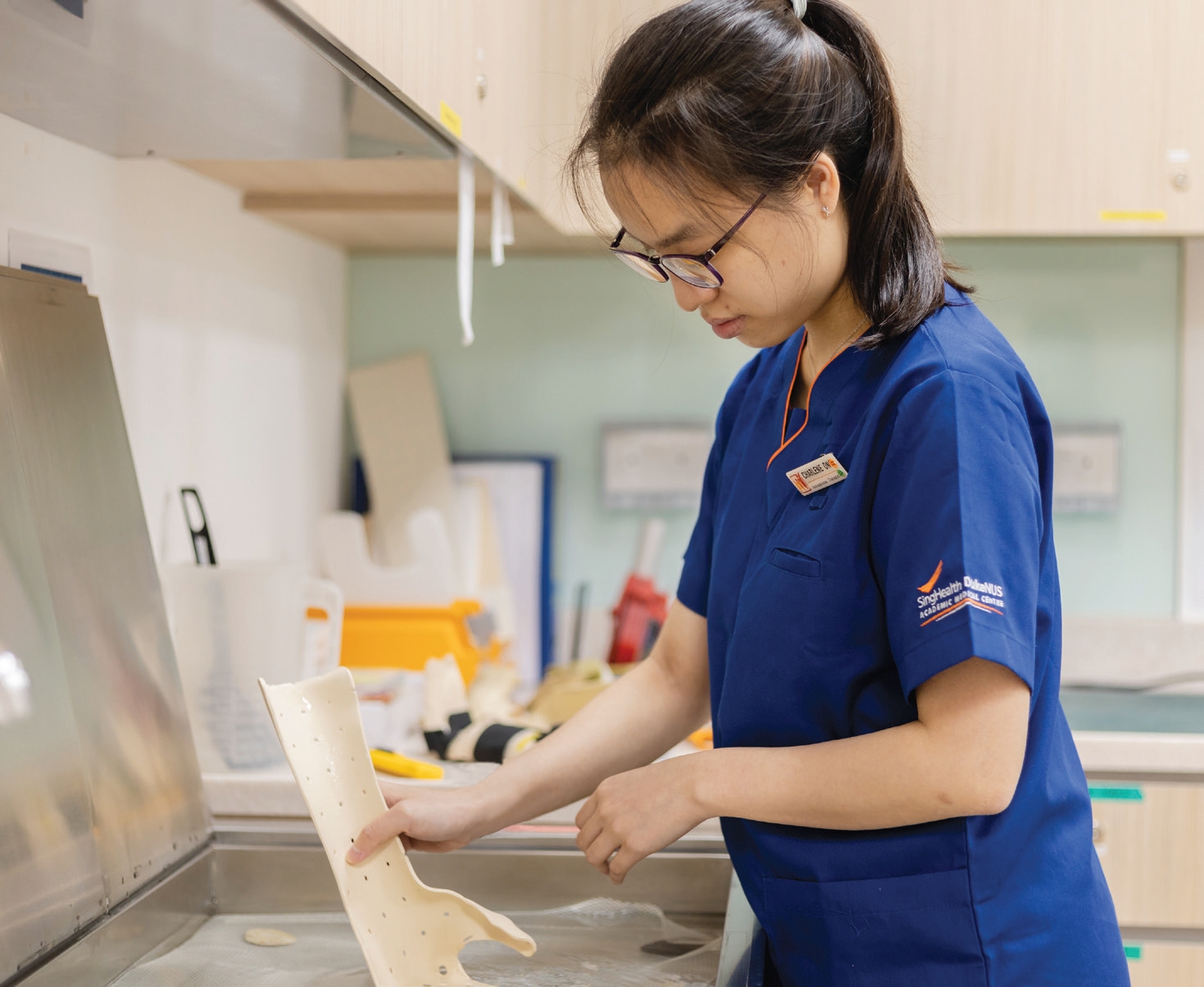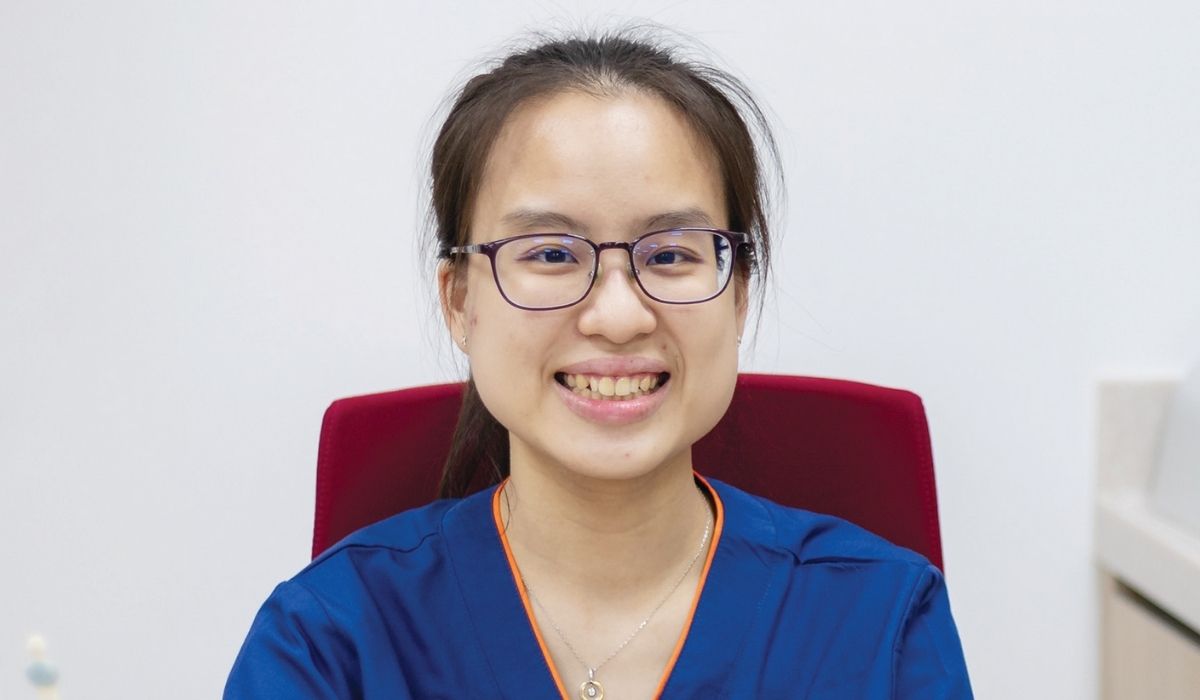Charlene Ong works as an Occupational Therapist and is the second-in-charge of the upper limb rehabilitation unit at Sengkang General Hospital. She is a scholarship recipient of the Healthcare Merit Award in 2013 and she holds a Bachelor of Science in Occupational Therapy from Singapore Institute of Technology.
We often associate medical treatment with doctors tending to wounds, or treating an ailment with medication or surgery. However for some patients, getting to full recovery requires a long-term and multi-faceted programme after an illness or disability, to re-learn basic skills and get back their prior quality of life. This is where Occupational Therapists come into the picture.
Occupational Therapists assess the strengths, weaknesses and most importantly, the needs of a patient and put together activities to help him or her regain a significant degree of independence. It is this very aspect of the Allied Health Profession that motivated Charlene Ong Xue Lin, to pursue the discipline as a career.
The Desire to Help
“I found out about Occupational Therapy while visiting Nanyang Polytechnic’s Open House, an event that happened at that time, and subsequently at the Healthcare Scholarships Fair organised by MOH Holdings (MOHH). Covering both my interests in the human body and mind, as well as allowing me to work with people from all walks of life, I felt drawn to the course,” enthused Charlene.
Driven by her ambition, she applied and subsequently accepted the Healthcare Merit Award (HMA), and then went on to pursue a Diploma in Occupational Therapy at Nanyang Polytechnic. Charlene furthered her studies and earned a Bachelor of Science in Occupational Therapy from SIT. The programme was jointly offered by SIT and Trinity College Dublin.
On her experience as a healthcare scholar, Charlene said: “My scholarship officer from MOHH would follow up with me periodically on how well I was coping at school. Get-togethers were also organised with my fellow scholars to form a platform of social support, and hearing my seniors share their experiences provided comfort and reassurance.”
“During the pre-COVID days, I also had the opportunity to be involved in an Overseas Community Involvement Programme (OCIP) to Cambodia with students from other Allied Health Professions, where we brainstormed and put together activities that improve the villagers’ well-being.”
A Leader and a Mentor
Currently, she is applying her knowledge and expertise as an Occupational Therapist at Sengkang General Hospital, where she is second-in-charge of the hospital’s upper limb rehabilitation unit, working with patients to regain the functionality of their shoulders, arms and hands.
“Being a second-in-charge constitutes managing manpower to support the daily operations, evaluating work processes, and advocating occupational therapy services to other healthcare professionals,” Charlene elaborated on her role.
She added: “In order to be prepared for any situation, we spend a lot of time evaluating and considering different factors that may affect our operations, coming up with solutions and contingency plans. One of those situations was when there was a surge in Covid-19 cases and we had to deploy manpower to help our colleagues in the inpatient wards.”
Beyond her operational role, Charlene encourages learning within her unit by coordinating weekly tutorials, allowing her colleagues to exchange ideas on processes and how they can do their jobs better.
One particular case she worked on left an indelible impression on her, validating her decision to be an Occupational Therapist. Charlene had a patient with a fingertip amputation, who often left every session in tears. Through understanding the patient more and gaining her trust, Charlene managed to have a breakthrough.
“I decided not to work on the physical aspects and instead, turned my focus towards her psychosocial and emotional coping mechanisms instead. This reminded me of the skills which I picked up through work – rapport building, therapeutic listening, and the mindfulness value of presence; which allowed this patient to share her most vulnerable thoughts with me, her therapist, who may just be a stranger to her.”
It was particularly gratifying for Charlene as she helped the patient overcome her psychological hurdle and in the process, the patient became more receptive to other forms of treatment. It also made Charlene realise that healthcare requires a holistic approach.
“This moment brought me joy and the reassurance that I had not lost or forgotten my soft skills, which is important in the healthcare industry where human interactions may be the most vulnerable.”
Charlene recalled the time she worked with medical Non-Government Organisation, HealthServe, where she helped migrant workers who were experiencing musculoskeletal-related problems. The experience broadened her perspectives as an Occupational Therapist.
“This interaction with them gave me a glimpse into their work conditions, as well as their limited resources, while living in dormitories. I had to also come up with more dynamic but practical solutions to their musculoskeletal issues. It also gave me the opportunity to learn more about them and understand their fears of repatriation after a work injury,” explained Charlene.

Opportunities Abound
Grateful for the numerous opportunities to gain career experience and develop professionally, Charlene emphasised that these occasions are the norm, rather than an exception.
“Even within my department, there are opportunities to hone one’s leadership skills. You’ll get the chance to organise our yearly Occupational Therapy Day Celebration, or even collaborate across departments to organise the Allied Health Day Celebration. Other opportunities include giving talks to promote the profession to other disciplines and participating in research studies with other professions in the aim to enhance clinical care, and so on.”
“As an Allied Health Professional (AHP), there is the option of various career pathways, namely clinical, education, research, or management tracks. AHPs who have an interest in conducting research studies, and finding the best evidence-based practice may find themselves suited for the research track. AHPs who see the importance of ensuring that the next generation of therapists receive the best education and training tend to have an interest in becoming an educator. There may also be AHPs who find joy in direct patient care and continuously upgrading their clinical skills, who may find that becoming a clinician fits them best.”
As for Charlene, she is thriving in the clinical track as it allows her to interact directly with patients.
“Doing that keeps my passion going in this profession,” she asserted. “Being in the clinical track also gives me the opportunity to evaluate and improve processes, and motivates me to stay up to date on my clinical skills and expertise.”
She concluded: “If you like human interactions and have that burning passion in you to empower others, healthcare will be suitable for you. It is a place where you can touch the lives of people you cross paths with whilst carving out a fulfilling career where job satisfaction is in the service itself.”



